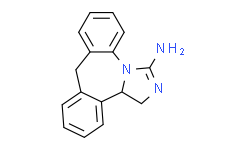| Cas No.: | 80012-43-7 |
| Chemical Name: | Epinastine |
| Synonyms: | Epinastine;3-amino-9,13b-dihydro-1h-dibenz[c,f]imidazo[1,5-a]azepine;Epinastine base;WAL801;3-Amino-9,13b-dihydro-1H-dibenzo[c,f]imidazo[1,5-a]azepine;9,13b-Dihydro-1H-dibenz[c,f]imidazo[1,5-a]azepin-3-amine;Flurinol(R) |
| SMILES: | C1=CC=C2C3CN=C(N)N3C3=CC=CC=C3CC2=C1 |
| Formula: | C16H15N3 |
| M.Wt: | 249.310403108597 |
| Purity: | >98% |
| Sotrage: | 2 years -20°C Powder, 2 weeks 4°C in DMSO, 6 months -80°C in DMSO |
| Description: | Epinastine(WAL801) is an antihistamine and mast cell stabilizer that is used in eye drops to treat allergic conjunctivitis.Epinastine shows a high affinity to H1-receptors in receptor binding studies in the guinea pig ileum. Epinastine inhibits histamine-induced reactions in the skin or the lung of rats, dogs and guinea pigs [1]. Epinastine is able to displace specific [3H]NC-5Z binding at low concentrations in the locust nervous tissue. Epinastine binds to the honey bees neuronal octopamine receptor with Ki of 1.1 nM. Epinastine antagonises octopamine-induced cAMP formation in the insect brain [2]. Epinastine causes an inhibition of histamine release from rat peritoneal mast cells induced by both antigen-antibody reaction and compound 48/80. Epinastine is similarly effective in inhibiting compound 48/80-induced histamine release not only from isolated rat peritoneal mast cells but also from rat mesenterial pieces. Epinastine is effective in inhibiting not only Ca2+ uptake into lung mast cells in actively sensitized guinea pigs but also Ca2+ release from the intracellular Ca store of rat peritoneal mast cells exposed to both compound 48/80 and substance P [3]. Epinastine shows a dose- and time-dependent suppressive effect on IL-8, one of the chemokines for eosinophils, released from eosinophils isolated from atopic diseases [4]. |
| Target: | Histamine Receptor |
| References: | [1]. Fugner, A., et al., In vitro and in vivo studies of the non-sedating antihistamine epinastine. Arzneimittelforschung, 1988. 38(10): p. 1446-53. [2]. Roeder, T., J. Degen, and M. Gewecke, Epinastine, a highly specific antagonist of insect neuronal octopamine receptors. Eur J Pharmacol, 1998. 349(2-3): p. 171-7. [3]. Kamei, C., et al., Antiallergic effect of epinastine (WAL 801 CL) on immediate hypersensitivity reactions: (I). Elucidation of the mechanism for histamine release inhibition. Immunopharmacol Immunotoxicol, 1992. 14(1-2): p. 191-205. [4]. Kohyama, T., et al., A novel antiallergic drug epinastine inhibits IL-8 release from human eosinophils. Biochem Biophys Res Commun, 1997. 230(1): p. 125-8. |

 DC Chemicals' products qualify for U.S. tariff exemptions. We guarantee no price increases due to customs duties and maintain stable supply, continuing to deliver reliable research solutions to our American clients.
DC Chemicals' products qualify for U.S. tariff exemptions. We guarantee no price increases due to customs duties and maintain stable supply, continuing to deliver reliable research solutions to our American clients.





















